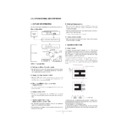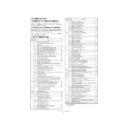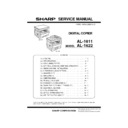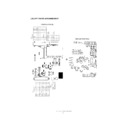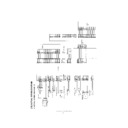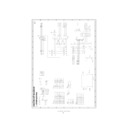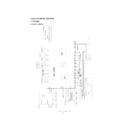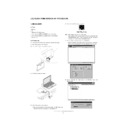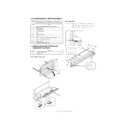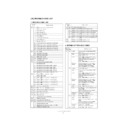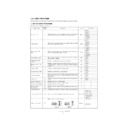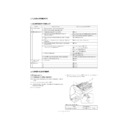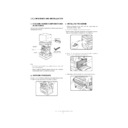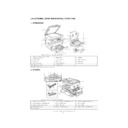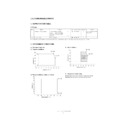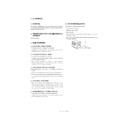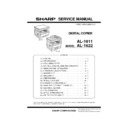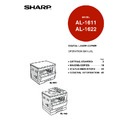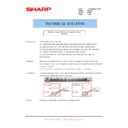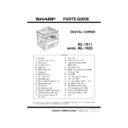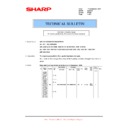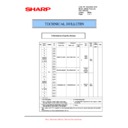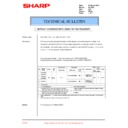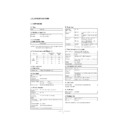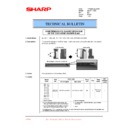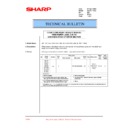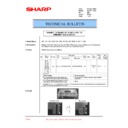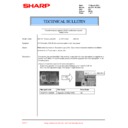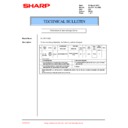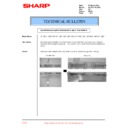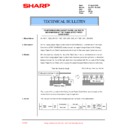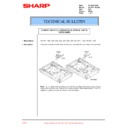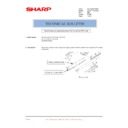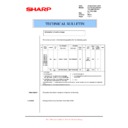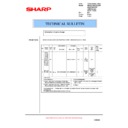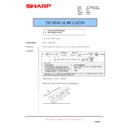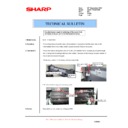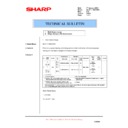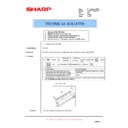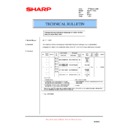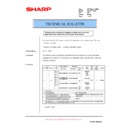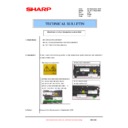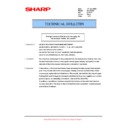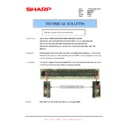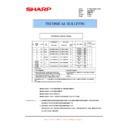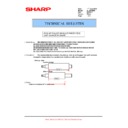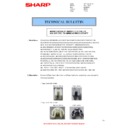Sharp AL-1622 (serv.man9) Service Manual ▷ View online
AL-1611/AL-1622
OPERATIONAL DESCRIPTIONS
6 – 4
(2) Exposure
A Laser beam is generated from the semiconductor laser and controlled
by the print pattern signal. The laser writes onto the OPC drum surface
by the print pattern signal. The laser writes onto the OPC drum surface
through the polygon mirrors and lens. The resistance of the OPC layer
decreases for an area exposed by the laser beam (corresponding to the
print pattern signal). The beam neutralizes the negative charge. An
print pattern signal). The beam neutralizes the negative charge. An
electrostatic latent image is formed on the drum surface.
(3) Developing (DC bias)
A bias potential is applied to the MG roller in the two component mag-
netic brush developing method, and the toner is charged negative
netic brush developing method, and the toner is charged negative
through friction with the carrier. Non-image area of the drum surface
charged with negative potential repel the toner, whereas the laser
exposed portions where no negative charges exist, attract the toner. As
exposed portions where no negative charges exist, attract the toner. As
a result, a visible image appears on the drum surface.
Toner is attracted over the shadowed area because of the developing
bias.
bias.
(4) Transfer
The visible image on the drum surface is transferred onto the print
paper by applying a positive charge from the transfer corona to the
paper by applying a positive charge from the transfer corona to the
backside of the print paper.
(5) Separation
Since the print paper is charged positively by the transfer corona, it is
discharged by the separation corona. The separation corona is con-
nected to ground.
nected to ground.
(6) Cleaning
Toner remaining on the drum is removed and collected by the cleaning
blade. It is transported to the waste toner collecting section in the clean-
blade. It is transported to the waste toner collecting section in the clean-
ing unit by the waste toner transport roller.
OPC layer
Pigment
layer
layer
Aluminum
OPC layer
Pigment
layer
layer
Aluminum
layer
layer
Drum surface charge
sfter the exposure
sfter the exposure
Non-image area
Image area
Semiconductor laser
Exposure
(semiconductor laser)
(semiconductor laser)
layer
S
N
N
MG roller
DC
-400v
-400v
-8V
: Carrier (Magnetized particle)
: Toner (Charge negative by friction)
(N) (S) : Pemanent magnet
(provided in three locations)
(provided in three locations)
-600
0
Toner attract
potential
potential
D
ru
m
s
u
rfac
e p
e p
o
te
nt
ia
l
Non-image area
Developing bias
Image area
Residual potential (-50 to -100V)
Charge
Exposure
Developing
Transfer
Discharge
Charge
Time
-400
AL-1611/AL-1622
OPERATIONAL DESCRIPTIONS
6 – 5
(7) Optical discharge (Semiconductor laser)
Before the drum rotation is stopped, the semiconductor laser is radiated
onto the drum to reduce the electrical resistance in the OPC layer and
eliminate residual charge, providing a uniform state to the drum surface
eliminate residual charge, providing a uniform state to the drum surface
for the next page to be printed.When the electrical resistance is
reduced, positive charges on the aluminum layer are moved and neu-
tralized with negative charges on the OPC layer.
tralized with negative charges on the OPC layer.
a. Charge by the Scorotron charger
<1> Function
The Scorotron charger functions to maintain the surface potential of the
drum even at all times which. It is used to control the surface potential
regardless of the charge characteristics of the photoconductor.
<2> Basic function
A screen grid is placed between the saw tooth and the photoconductor.
A stable voltage is added to the screen grid to maintain the corona cur-
A stable voltage is added to the screen grid to maintain the corona cur-
rent on the photoconductor. As the photoconductor is charged by the
saw tooth from the main corona unit, the surface potential increases.
This increases the current flowing through the screen grid. When the
This increases the current flowing through the screen grid. When the
photoconductor potential nears the grid potential, the current turns to
flow to the grid so that the photoconductor potential can be maintained
at a stable level.
at a stable level.
b. Process controlling
<1> Function
The print pattern signal is converted into an invisible image by the semi-
conductor laser using negative to positive (reversible) developing
conductor laser using negative to positive (reversible) developing
method. Therefore, if the developing bias is added before the drum is
charged, toner is attracted onto the drum. If the developing bias is not
added when the drum is charged, the carrier is attracted to the drum
added when the drum is charged, the carrier is attracted to the drum
because of the strong electrostatic force of the drum.
To avoid this, the process is controlled by adjusting the drum potential
and the grid potential of the Scorotron charger.
and the grid potential of the Scorotron charger.
<2> Basic function
Voltage added to the screen grid can be selected, high and low.To
make it easily understood, the figure below shows voltage transition at
the developer unit.
<3> Start
1) Because the grid potential is at a low level, the drum potential is at
about -400V. (Carrier may not be attracted though the carrier is
pulled towards the drum by the electrostatic force of -400V.)
2) Developing bias (-400V) is applied when the photoconductor poten-
tial is switched from LOW to HIGH.
3) Once developing bias (-400V) is applied and the photo conductor
potential rises to HIGH, toner will not be attracted to the drum.
<4> Stop
The reverse sequence takes place.
c. Retaining developing bias at an abnormal occurrence
<1> Function
The developing bias will be lost if the power supply was removed during
print process. In this event, the drum potential slightly abates and the
carrier makes deposits on the drum because of strong static power. To
prevent this, the machine incorporates a function to retain the develop-
prevent this, the machine incorporates a function to retain the develop-
ing bias for a certain period and decrease the voltage gradually against
possible power loss.
<2> Basic function
Normally, the developing bias voltage is retained for a certain time
before the drum comes to a complete stop if the machine should stop
before the drum comes to a complete stop if the machine should stop
before completing the normal print cycle. The developing bias can be
added before resuming the operation after an abnormal interruption.
Therefore, carrier will not make a deposit on the drum surface.
Therefore, carrier will not make a deposit on the drum surface.
4. LASER UNIT
The image data sent from the MCU (image process circuit) is sent to the
LSU (laser unit), where it is converted into laser beams.
A. Basic structure
The LSU unit is the writing section of the digital optical system.The
semiconductor laser is used as the light source, and images are formed
on the OPC drum by the polygon mirror and fq lens, etc.
The laser beams are passed through the collimator lens, the cylindrical
lens, the polygon mirror, the fq lens, and the mirror to form images on
the OPC drum in the main scanning direction. The laser emitting PWB
the OPC drum in the main scanning direction. The laser emitting PWB
is provided with the APC (auto power control) in order to eliminate fluc-
tuations in the laser power. The BD PWB works for measurement of the
laser writing start point.
laser writing start point.
Semiconductor laser
0
START
STOP
Print potentioal
Toner attract
potential
potential
2)
3)
1)
Low
4)
High
Drum potential
Developing bias
Time
1
Semiconductor laser
Generates laser beams
2
Collimator lens
Converges laser beams in parallel
3
Polygon mirror,
polygon motor
polygon motor
Reflects laser beams at a constant rpm
4
BD (Mirror, lens, PWB) Detects start timing of laser scanning
5
f
θ
lens
Converges laser beams at a spot on
the drum.
Makes the laser scanning speeds at
both ends of the drum same as each
other. (Refer to the figure below.)
the drum.
Makes the laser scanning speeds at
both ends of the drum same as each
other. (Refer to the figure below.)
6
Laser emitting PWB
Emits laser beams according to the
image data.
image data.
6
5
2
1
3
4
AL-1611/AL-1622
OPERATIONAL DESCRIPTIONS
6 – 6
Makes the laser scanning speeds at both ends of the drum same as
each other.
each other.
B. Laser beam path
5. PAPER FEED SECTION
A. Basic structure
a
≠
b
≠
c
a
b
c
d = e = f
d e
f
1
No. 1 cassette paper feed roller (Semi-circular roller)
Picks up paper from No. 1 cassette.
2
Main motor
Drives the process section and the paper transport section.
3
No. 1 cassette paper feed solenoid
Rotates and controls No. 1 cassette paper feed roller.
4
No. 1 cassette paper feed roller clutch
Drives No. 1 cassette paper feed roller.
5
Manual paper feed roller
Picks up paper from the manual paper feed tray.
6
Manual paper transport roller
Transport paper which was picked up from the manual paper feed tray.
7
Manual paper feed roller clutch
Drives the manual paper feed roller.
8
Manual paper transport roller clutch
Drives the manual paper transport roller.
9
Manual paper feed roller solenoid
Rotates and controls the manual paper feed roller.
10
Manual paper transport roller solenoid
Rotates and controls the manual paper transport roller.
11
Resist roller
Takes synchronization between the paper lead edge and the image lead edge.
12
Resist roller clutch
Drives the resist roller.
13
Resist roller solenoid
Rotates and controls the resist roller.
AL-1611/AL-1622
OPERATIONAL DESCRIPTIONS
6 – 7
B. Brief descriptions of operations
This machine allows two ways of paper feed system: cassette paper
feed and manual paper feed.
The cassette of universal type is employed to hold 250 sheets. The
The cassette of universal type is employed to hold 250 sheets. The
front loading system allows to attach or detach the cassette from the
front of the machine.
Paper size can be selected by the user.
Paper size can be selected by the user.
Since this model is not equipped with the automatic paper select func-
tion, paper size detection is not performed.
(1) Cassette paper feed operation
Select the cassette and press the START button, and the paper feed
roller solenoid will be turned on and the paper feed clutch will be
roller solenoid will be turned on and the paper feed clutch will be
released.
The drive power of the main motor is transmitted through the paper feed
roller clutch to the paper feed roller, rotating the paper feed roller and
feeding paper.
feeding paper.
(2) Manual paper feed tray operation
Select the manual paper feed tray and press the START button, and the
manual paper feed roller will be turned on to bring the paper feed roller
in contact with paper and lift the shutter simultaneously.
The drive power of the main motor is transmitted through the manual
The drive power of the main motor is transmitted through the manual
paper feed roller clutch to the manual paper feed roller, rotating the
manual paper feed roller and feeding paper.
(3) Resist roller
In order to make synchronization between the paper lead edge fed from
the paper feed port and the image lead edge, the roller is kept station-
the paper feed port and the image lead edge, the roller is kept station-
ary for a certain time after the paper reaches at the roller towarp the
paper a little.
When the paper is warped to a certain level, the resist roller solenoid is
When the paper is warped to a certain level, the resist roller solenoid is
turned on to release the resist roller clutch.
The drive power of the main motor is transmitted through the resist
roller clutch to the resist roller, rotating the resist roller and feeding
roller clutch to the resist roller, rotating the resist roller and feeding
paper.
6. FUSING SECTION
A. Basic composition
(Top view)
B. Heat roller
A pressure roller is used for the heat roller and a silicone rubber roller is
used for the lower heat roller for better toner fusing performance and
paper separation.
paper separation.
C. Separator pawl
Four separator pawls are used on the upper heat roller. The separator
pawls are teflon coated to reduce friction with the roller and prevent a
smear on the paper caused by the separator pawl.
D. Thermal control
1) The heater lamp, thermistor, main PWB, DC power supply PWB,
and triac within the power supply unit are used to control the tem-
perature in the fuser unit. To prevent against abnormally high tem-
perature in the fuser unit, a thermostat is used for safety purposes.
2) The surface temperature of the upper heat roller is set to 180°C ~
195°C. The surface temperature during the power save mode is set
to 100°C.
to 100°C.
5
4
3
2
1
8
6
7
1
Before-fusing
paper guide
paper guide
Guides the paper transported from the process
section to the fusing unit.
section to the fusing unit.
2
Upper heat
roller
roller
Applies heat and pressure to the paper to fuse.
3
Thermistor
Detects the surface temperature of the upper
heat roller.
heat roller.
4
Thermostat
Stops power supply to the heat roller in case of
an abnormally high temperature of the heat
roller.
an abnormally high temperature of the heat
roller.
5
Separation
pawl
pawl
Separates the print paper from the upper heat
roller.
roller.
6
POD1
Detects that the paper has been transported
from the fusing section.
from the fusing section.
7
Heater lamp
Heats the heat roller.
8
Lower heat
roller
roller
Applies a pressure to the paper together with
the upper heat roller.
the upper heat roller.
2
7
5
8
4
3
Safety device
(thermal breaker, thermal
(thermal breaker, thermal
fuse)
Triac (in the
power supply unit)
power supply unit)
Heated by the
heater lamp.
(950W )
The surface temperature
of the upper hea t roller
is sensed by the thermistor.
Level of the thermistor is
controlled by the main PWB.
controlled by the main PWB.
With the signal from the
main PWB, the triac is
main PWB, the triac is
controlled on and off.
(power supply PWB )
Display

